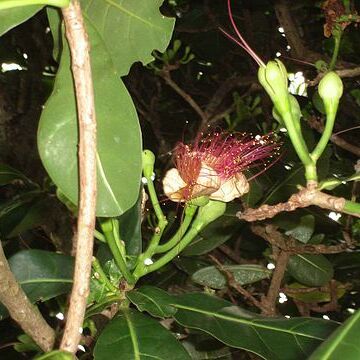Trees or shrubs. Leaves simple, alternate, exstipulate or stipules small. Flowers usually rather large and showy, regular or irregular, hermaphrodite. Calyx 2–6-lobed or circumscissile, if the lobes free then valvate or slightly imbricate. Petals 4–6 or lacking, free or connate at the base. Stamens numerous, in several rows, free or mostly basally united into a short tube, the inner filaments shorter and often without anthers; anthers basifixed or rarely adnate, opening by slits. Ovary inferior or half-inferior, 1–6(–many)-locular; ovules 1–many in each locule, axile or pendulous from near the apex; style simple or shortly branched at the apex. Fruit woody, fibrous or fleshy, indehiscent or operculate. Seeds without or with thin endosperm; embryo straight or curved, sometimes solid and undifferentiated, but in many genera with normal cotyledons
Trees or shrubs. Leaves simple, alternate, shortly petiolate, usually crowded towards apex of branchlet; stipules usually absent. Flowers actinomorphic or zygomorphic, bisexual; aestivation valvate or imbricate. Calyx 4–6 (rarely 2 or 3)–lobed. Petals 4–6, free, rarely absent. Stamens many, in several series, free, often several sterile, either monadelphous and equally arranged around disc, or diadelphous in 2 unequal bundles, the larger usually hood-like over gynoecium; anthers basifixed, up to 2 mm long in Australian taxa, bilocular, opening by longitudinal slits. Disc sometimes lobed. Ovary inferior or semi-inferior, 2–to several-locular; ovules 1 to many per locule; placentation axile; style simple, rarely divided or dilated. Fruit an indehiscent berry or operculate capsule, often crowned by calyx-lobes. Seed without endosperm.
Stamens numerous, in several series, sometimes the outer ones modified into staminodes and resembling a corona; filaments mostly united; anthers basifixed or rarely adnate, opening at the side by slits; staminal disk sometimes lobed
Ovary inferior or semi-inferior, 2-or more-celled; style mostly simple; ovules 1 to many on axile placentas, sometimes pendulous from near the apex of the cells
Trees or shrubs; leaves simple, alternate, not gland-dotted but sometimes with large glands on the margin; stipules absent
Flowers usually rather large and showy, actinomorphic or zygomorphic, hermaphrodite
Petals 4–6, free or united into a campanulate tube and then with many ribs
Fruit woody, fibrous or fleshy, indehiscent or operculate at the apex
Seeds without endosperm; embryo divided or entire
Calyx 4–6-lobed, lobes valvate or imbricate

